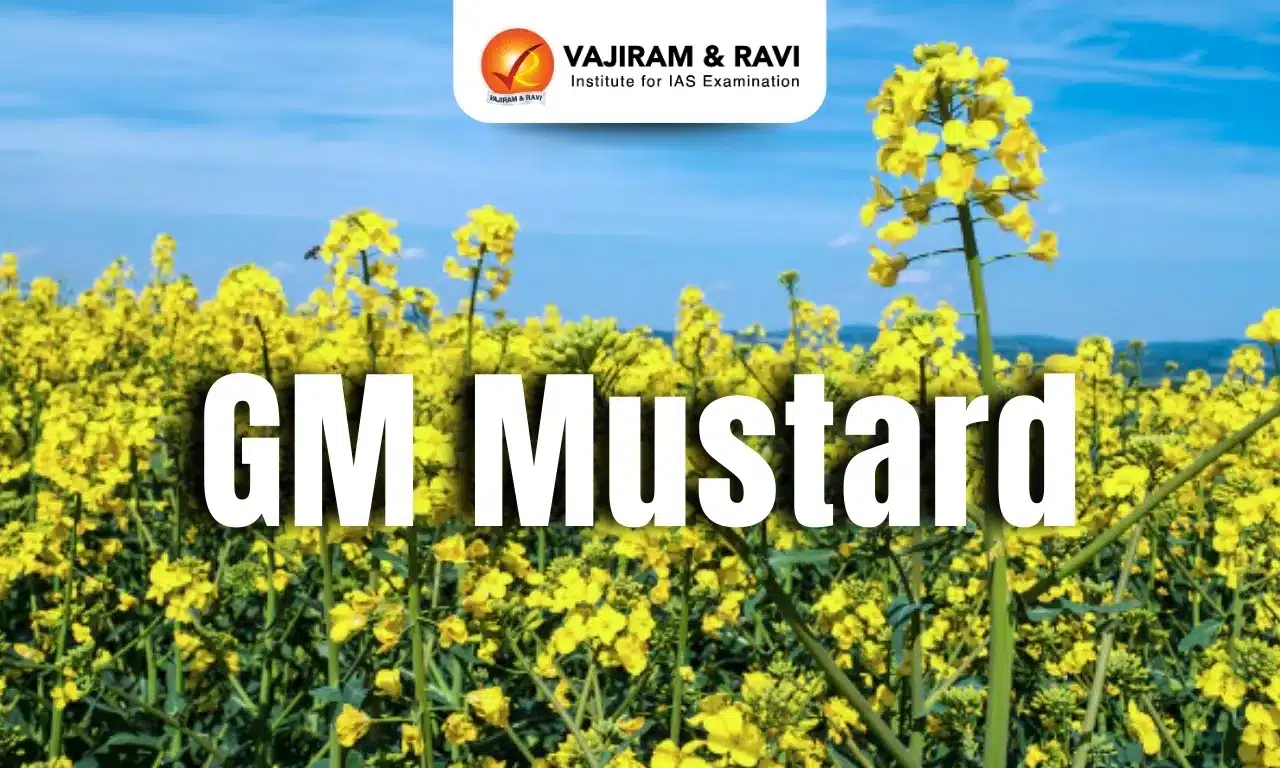GM Mustard DMH-11 is created by crossing the Indian variety Varuna with the Eastern European variety ‘EarlyHeera-2’. It has been claimed that the yield of DMH-11 is 28 percent higher than Varuna. This hybrid is developed by mixing the genes of two different varieties of a plant from the same species. The first-generation offspring of such cross crops give a higher yield than both parents.
Development of GM Mustard
Breeders used the Cytoplasmic Male Sterility System, turning to a gene in wild mustard that impedes pollen formation. This gene, which occurs in the cell’s cytoplasm, is transferred to cultivated mustard by repeatedly crossing both plants. The cultivated mustard, Brassica juncea, has stopped producing pollen and can now function as a female parent.
- Then, another gene from wild mustard is transferred to another variety of Brassica juncea, which becomes the male parent, to reverse the pollen sterility caused by the first gene.
- These two are then crossed to create a hybrid of both Brassica varieties. To add a trait to a crop plant, a gene is inserted along with the additional genetic material, which helps in the expression of new traits in the plant.
- Marker genes help in the determination of expressed new traits in the plant.
- Herbicides and antibiotic-tolerant promoters are used for the identification of transformed plants.
Dhara Mustard Hybrid (DMH-11)
DMH-11 was created by a team of scientists from Delhi University’s Centre for Genetic Manipulation of Crop Plants (CGMCP) with assistance from the National Dairy Development Board (NDDB) and the Department of Biotechnology.
- The transgenic hybrid is developed by hybridising an Indian mustard variety called Varuna with the east European ‘EH-2’.
- The DMH-11 has been developed using the genetic male sterility (GMS) technique, especially the ‘barstar-barnase’ system, to make herbicide resistant.
- The new method can produce pure seed almost 99% of the time.
- This means that the transgenic mustard will be able to reach more farmers than its predecessor.
- DMH-11 is based on the Barnase-Barstar system.
- The Barnase gene codes for a protein that hinders pollen production.
- The plant into which the Barnase gene is introduced made it male-sterile and left it only capable of receiving pollen from another parent.
- A plant having a fertile, potent male part contains the Barstar gene, which blocks the action of the Barnase gene.
- The resultant F1 progeny is both high-yielding and potent to produce seed/grain, in the second male-fertile line.
- Bio-safety research level field trials done on DMH-11 have reported a roughly 30% more yield advantage over the Varuna ‘check’ variety carried out between 2010-11 and 2014-15.
Necessity of GM Mustard in India
DMH-11 is vital to making India self-sufficient in edible oils. During 2021-22, domestic edible oil production stood at 116.5 lakh tonnes and imports at 141.93 lakh tonnes. At the current consumption rate, India will need 34 million tonnes of edible oils by 2025-26, which will put significant pressure on the country’s foreign exchange reserves.
- Mustard has the potential to turn around the situation, as it contributes 40 percent of total edible oil production in India.
- At present, mustard is grown on eight million hectares, with an average yield of 1-1.3 tonnes per hectare.
- Transgenic seeds have the potential to increase yields to 3-3.5 tonnes per hectare.
- In 2022, the Genetic Engineering Appraisal Committee (GEAC) approved the environmental release of Genetically Modified (GM) Mustard hybrid DMH-11 and its parental lines for seed production and testing.
Advantages of GM Mustard
The following are some advantages of GM Mustard:
- Boost to Production: According to some experts, DMH-11 can increase yield by 25 to 30 percent despite using less water, chemical fertilizers, and pesticides.
- Opens the Pathway for More Genetic Research: DMH-11 opens up the possibility for further genetic engineering research toward developing mustard hybrids with other selective traits such as better input efficiency, better product quality, and higher pest
resistance.
- Recently, the GEAC has recommended field trials for GM hybrids of Banana, Cotton, Potato, and Rubber.
- Pest Management: GM mustard has been modified to be resistant to the broad-spectrum plant-killer or herbicide glufosinate.
- This facilitates the development of hybrid mustard seeds with higher yields.
- Herbicide Tolerant: The use of herbicides in herbicide tolerant (HT) crops has an advantage in terms of saving soil moisture and nutrients, besides effective weed control.
Concerns associated with GM Mustard
The introduction of GM mustard may improve the country’s self-sustenance in the production and consumption of edible oil and decrease dependency on imports but it comes with some serious concerns.
- Honey Production: GM mustard has mutated flowering and pollen production and, as a result, can affect honeybees directly or indirectly. Protease inhibitors have proved unfavourable to the longevity and behaviour of bees.
- However, the expert committee noted that based on the examination of scientific evidence available globally, it seems unlikely that the barstar system (of genes) will adversely impact bees and other pollinators.
- Health Concerns: Genetic modification with the genes bar, bacterial protein Barnese and barstar used to prepare GM mustard seed has never been a part of the human diet, so introducing the genes can create novel proteins with unknown impacts.
- Use of Herbicide:The DMH-11 mustard variety is herbicide tolerant, allowing farmers to spray over the crops with weed killer. Excessive use of toxic herbicides could lead to weeds becoming resistant and the emergence of superweeds.
- Unemployment: GM Mustard contains a third-time gene that makes it weedicide glufosinate ammonium tolerant. Earlier manual labour had to be employed to remove weeds, now the work will be done by adding chemicals.
Last updated on April, 2025
→ UPSC Notification 2025 was released on 22nd January 2025.
→ The UPSC Vacancy 2025 were released 1129, out of which 979 were for UPSC CSE and remaining 150 are for UPSC IFoS.
→ As per UPSC Notification, the last date to apply is 18th February 2025.
→ The UPSC Prelims 2025 is scheduled to be conducted on 25th May 2025 and UPSC Mains 2025 will be conducted on 22nd August 2025.
→ Apply once through it and aspirants can apply for various government exams conducted by UPSC.
→ The UPSC Selection Process is of 3 stages-Prelims, Mains and Interview.
→ UPSC Result 2024 is released with latest UPSC Marksheet 2024. Check Now!
→ UPSC Toppers List 2024 is released now. Shakti Dubey is UPSC AIR 1 2024 Topper.
→ Also check Best IAS Coaching in Delhi
GM Mustard FAQs
Q1. What is the GM variety of Indian mustard?+
Q2. Is GM Mustard approved in India?+
Q3. What are the issues with GM Mustard?+
Q4. Why is GM mustard needed in India?+
Tags: gm mustard quest
















